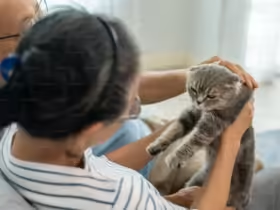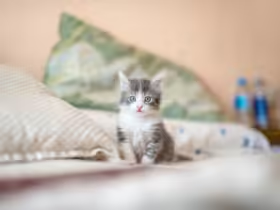Mastitis is a painful condition that can affect nursing cats and their kittens, making the nursing process difficult and uncomfortable. Understanding mastitis, its symptoms, causes, and treatment options is crucial for ensuring the health and well-being of both the mother cat and her kittens. This comprehensive guide will help you identify if your cat might be suffering from mastitis and provide you with steps to address this condition effectively.
What is Mastitis?
Definition
Mastitis is an inflammation of the mammary glands (breast tissue) that can occur in lactating cats. This condition often results in swelling, redness, and tenderness of the affected mammary glands, which can interfere with the nursing process.
Causes of Mastitis
Several factors can lead to mastitis in cats:
- Bacterial Infection: The most common cause, typically resulting from bacteria entering the mammary glands through cracked or injured nipples.
- Blocked Milk Ducts: Milk buildup can lead to infection and inflammation.
- Trauma or Injury: Injury to the mammary glands can make them more susceptible to infection.
- Poor Hygiene: Lack of cleanliness in the nursing area can contribute to bacterial growth.
Recognizing the Symptoms of Mastitis
Common Signs
Observe the following signs to determine if your cat might have mastitis:
- Swollen Mammary Glands: One or more of the mammary glands may appear swollen, firm, or enlarged.
- Redness: The affected area may be red or inflamed.
- Heat: The swollen glands may feel warm to the touch.
- Pain: Your cat may exhibit signs of discomfort or pain when the mammary glands are touched.
- Discharge: You might notice pus or a milky discharge from the affected nipple.
Behavioral Changes
In addition to physical symptoms, mastitis can lead to behavioral changes:
- Reluctance to Nurse: The mother cat may be unwilling or reluctant to nurse her kittens due to pain.
- Aggression or Irritability: Pain and discomfort can make the cat more irritable or aggressive.
- Decreased Appetite: Affected cats might eat less due to general discomfort.
Diagnosing Mastitis
Veterinary Examination
If you suspect mastitis, it’s essential to seek veterinary care for a proper diagnosis. The vet will typically:
- Conduct a Physical Exam: To assess the mammary glands and check for signs of inflammation, redness, and pain.
- Perform Diagnostic Tests: Depending on the severity and suspected cause, tests may include:
- Milk Culture: To identify the specific bacteria causing the infection.
- Blood Tests: To assess overall health and detect any systemic issues.
- Ultrasound or X-rays: In cases where deeper issues or abscesses are suspected.
Treating Mastitis
Immediate Care
Prompt treatment is crucial to alleviate pain and prevent further complications:
- Antibiotics: If a bacterial infection is present, your vet will prescribe antibiotics to eliminate the infection. Complete the full course of medication as directed.
- Pain Relief: Pain medications or anti-inflammatory drugs may be prescribed to help manage discomfort and reduce inflammation.
Supportive Care
In addition to veterinary treatment, supportive care is essential:
- Keep the Area Clean: Maintain cleanliness around the nursing area to reduce the risk of further infection.
- Encourage Nursing: Ensure that kittens continue to nurse if the mother cat is able. Proper nursing is crucial for the kittens’ nutrition and health.
- Monitor for Abscesses: Watch for any signs of abscess formation or worsening of symptoms, which may require additional veterinary intervention.
Addressing Underlying Issues
If mastitis is due to an underlying problem, such as blocked milk ducts or injury, your vet will provide specific treatment recommendations:
- Milk Duct Blockage: Techniques to relieve the blockage may be suggested, such as gentle massage or warm compresses.
- Injury Management: If trauma is the cause, appropriate care and treatment will be advised.
Preventing Mastitis
Proper Hygiene
Maintaining cleanliness is vital to preventing mastitis:
- Clean Environment: Ensure the whelping area where the mother cat gives birth and nurses is clean and dry.
- Monitor Nipples: Regularly check the nipples for signs of injury or infection.
Health Monitoring
Regular monitoring of the mother cat’s health during and after pregnancy can help prevent mastitis:
- Regular Vet Check-Ups: Schedule veterinary exams to monitor the health of both the mother cat and her kittens.
- Observe for Early Signs: Promptly address any early signs of mastitis or other health issues.
Avoid Overcrowding
Ensure that the mother cat has a comfortable and stress-free environment. Overcrowding or excessive handling can increase stress and the risk of infection.
Caring for Kittens
Ensuring Adequate Nutrition
If the mother cat is unable to nurse due to mastitis, it’s crucial to ensure the kittens receive adequate nutrition:
- Supplemental Feeding: Use a commercial kitten milk replacer if the mother cat cannot nurse. Consult your vet for recommendations on feeding schedules and quantities.
- Monitor Growth: Ensure that the kittens are gaining weight and growing appropriately.
Keeping Kittens Warm
Kittens are unable to regulate their body temperature effectively, so keep them warm and comfortable:
- Provide a Heating Pad: Use a heating pad set on low to maintain a warm environment for the kittens.
When to Seek Immediate Veterinary Help
Seek immediate veterinary assistance if:
- Severe Symptoms: If the mother cat exhibits severe symptoms such as high fever, persistent pain, or the formation of abscesses.
- Kittens are Not Nursing: If the kittens are not nursing and are showing signs of distress or malnutrition.











Leave a Reply